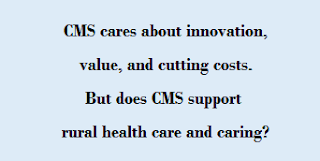The CMS Contribution to the Devastation of Rural Health
Searching on CMS and rural health is revealing. There are regular headlines with regard to reports and proposals and programs. The themes of innovation and quality grab the attention. But there has been a continued lack of progress where it matters most - in Rural Health Care and the Ability to Care
In the last decade even worse has been the case. The next decade seems to have the potential for devastation to rural health.
CMS says rural health needs major improvements in quality,
but CMS leads the nation to pay too little resulting in half enough generalists
and general specialists – those who provide 90% of rural services in the places
with limitations of quality, outcomes, workforce, and access.
Quality and outcomes are actually about the situations,
conditions, relationships, and environments as well as income, housing, jobs,
education, and other social determinants. CMS contributes to lesser social determinants
by designs that send 15% less to rural practices and 30% less to rural
hospitals for the same services.
Burnout, high turnover, low productivity, and
fewer team members to share the load are about the financial design as designed
by CMS in past decades made worse recently.
CMS is a major reason for quality and outcome problems.
CMS says rural health needs innovation.
Sadly there is a
misguided belief that innovation can fix all problems. Innovation is about change - costly change. Change is hardest on those smaller, rural, and least supported.
Digitalization made
matters worse as seen in rural primary care practices that must pay $60,000 to
$100,000 more per primary care physician for HITECH to present digital
innovations.
MACRA is another payment
innovation that costs about $40,000 per primary care physician for those
largest and most organized and most urban with twice the cost for those most in
need of a break financially.
Medicare 2011 data revealed 15 – 20% lower office payments
for rural primary care practices – in places that already have lower to lowest
collections.
Primary Care Medical Home has been pushed but is $80,000 and up
cost per primary care physician in rural practices.
Innovation actually hurts
delivery capacity, productivity, morale, and access. The usual disruptions of major changes in personnel, practice, software, location, and situation are difficult for small and medium size practices. Innovation complicates the usual disruptions. There is as yet no adjuster for the usual disruptions and only 2 papers so far on this most important area. What Primary Care Researchers Should Be Researching - Disruptions in Primary Care Practices
It is not possible to innovate, coordinate,
outreach, or perform higher functions when the basic support for physicians,
clinicians, and team members has been compromised. You must first have the people to do the work so that they can do the most important work of adapting their care to their population in their location. Supported health care teams naturally innovate, coordinate, and outreach at all levels.
The lack of support is also reflected in
$100,000 cost per primary care physician FTE per year in turnover costs and
lost revenue due to $300,000 per loss and losses every 3 years or sooner. Once again the financial design of CMS impacts every aspect of rural practice and primary care where most Americans most lack primary care. CMS has written away 8 billion dollars from the 38 billion that once flowed to primary care practices where Americans had half enough dollars already.
CMS is a major reason for the lack of innovation.
CMS has
also punished small, rural, less organized,
and most needed providers by
misguided attempts at innovation.
As far as value based, many rural primary care physicians
have the same outcomes despite getting paid 15 – 25% less. In the value based
equation, they are the most valuable. Instead, CMS wants to train them in
value-based. Not surprisingly those who know their practices and populations
are upset by CMS in this and in other areas. How Can CMS Improve Value in the Most Valuable?
CMS has resulted in billions more diverted from rural
practices and hospitals to go to consultants, software companies, and others
who benefit from digitalization, regulation, and innovation. These are billions
fewer to invest in those who deliver care in rural locations and billions less
to improve rural communities, people, and outcomes.
CMS has been the problem with regard to access, cost of delivery, quality, and outcomes for decades. The last one was bad. The next decade is likely to be the worst of all.

Comments
Post a Comment